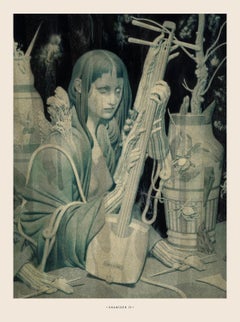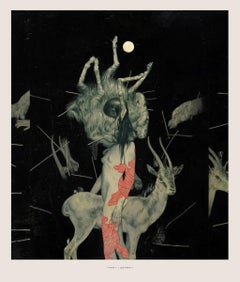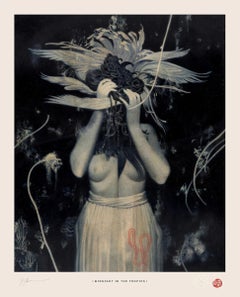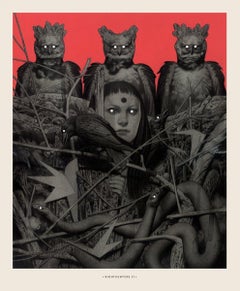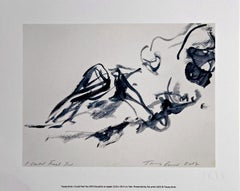Joao Ruas Prints and Multiples
to
2
2
Overall Width
to
Overall Height
to
4
1,170
922
886
814
4
4
4
4
4
Artist: Joao Ruas
Shamisen II Signed and Numbered Print Macabre Illustration
By Joao Ruas
Located in Draper, UT
João Ruas
“Shamisen II”
Limited edition giclée fine art print
Description
This is Shamisen II, a signed, embossed and stamped limited edition giclée print by João Ruas. Created usin...
Category
2010s Joao Ruas Prints and Multiples
Materials
Black and White, Archival Pigment
Hunt Gather Signed and Numbered Print Macabre Illustration
By Joao Ruas
Located in Draper, UT
For sale is an exceptional fine art print titled "Hunt Gather" by the talented Brazilian artist João Ruas. This beautiful giclée print is printed on 350 gsm 100% Cotton Hahnemühle Mu...
Category
2010s Joao Ruas Prints and Multiples
Materials
Black and White, Archival Pigment
Midnight in the Tropics Signed and Numbered Print Macabre Illustration
By Joao Ruas
Located in Draper, UT
For sale is an exceptional fine art print titled "Midnight in the Tropics" by the talented Brazilian artist João Ruas. This beautiful giclée print is printed on 350 gsm 100% Cotton H...
Category
2010s Joao Ruas Prints and Multiples
Materials
Black and White, Archival Pigment
Nighthunters II Signed and Numbered Print Macabre Illustration
By Joao Ruas
Located in Draper, UT
For sale is an exceptional fine art print titled "Nighhunter II" by the talented Brazilian artist João Ruas. This beautiful giclée print is printed on 350 gsm 100% Cotton Hahnemühle ...
Category
2010s Joao Ruas Prints and Multiples
Materials
Black and White, Archival Pigment
Related Items
I Could Feel You, Tracey Emin, rare 2015 giclee print plate signed 300 gsm paper
By Tracey Emin
Located in New York, NY
Tracey Emin
I Could Feel You, 2015
Archival quality giclée print on Purcell Ultrasmooth Fine Art Paper 300 GSM
9 1/2 × 12 inches
Plate signed
Unframed
Rare archival quality, giclée reproduction of Tracey Emin's original gouache I Could Feel You, which is in the permanent modern art collection of the Tate. This was printed back in 2015 in an undisclosed limited edition, and is now long sold out.
More details about the original 2014 work are on the Tate Gallery's website as follows:
Emin, whose work is often candidly autobiographical, scrutinises her relationship with her own body, using drawing...
Category
2010s Contemporary Joao Ruas Prints and Multiples
Materials
Giclée
Dame Creole
By Henry Moore
Located in San Francisco, CA
Artist: Henry Moore (British, 1898-1986)
Title: Dame Creole
Year: 1976
Medium: Color lithograph
Edition: 110
Paper: Arches
Image size: 18.5 x 15 inches
paper size: 18.5 x 15 i...
Category
1970s Abstract Joao Ruas Prints and Multiples
Materials
Lithograph
Les Poetes, La Poesie, Front Page
By Henry Moore
Located in San Francisco, CA
Artist: Henry Moore (British, 1898-1986)
Title: Les Poetes, La Poesie, Front Page
Year: 1976
Medium: Color lithograph
Edition: 110
Paper: Arches
Paper...
Category
1970s Abstract Joao Ruas Prints and Multiples
Materials
Lithograph
ARCHANGEL (XL Size)
Located in FITZROY, VIC
Nick Thomm ARCHANGEL (XL SIZE 36" x 48").
Limited Edition #22 of 25.
Hand Signed & Numbered.
Archival Pigment Print on Hahnemühle 308gsm Fine Art Paper.
Condition: NEW - Unopened in...
Category
21st Century and Contemporary Abstract Joao Ruas Prints and Multiples
Materials
Archival Ink, Giclée, Archival Pigment
Nick Thomm - GHOSTS (BLUE)
Located in FITZROY, VIC
Nick Thomm 'GHOSTS' (Blue)
69cm x 92cm (27"×36″)
Limited Edition of 199
Hand Signed and Numbered #113
Archival Pigment Print on Hahnemühle 308gsm Fine Art Paper.
Condition: NEW.
Wo...
Category
21st Century and Contemporary Abstract Joao Ruas Prints and Multiples
Materials
Archival Ink, Giclée, Archival Pigment
Nick Thomm - AFTER DARK (GREEN)
Located in FITZROY, VIC
Nick Thomm 'After Dark' (Green)
69cm x 92cm (27"×36″)
Limited Edition of 125
Hand Signed and Numbered #104
Archival Pigment Print on Hahnemühle 308gsm Fine Art Paper.
Condition: NE...
Category
21st Century and Contemporary Abstract Joao Ruas Prints and Multiples
Materials
Archival Ink, Giclée, Archival Pigment
Nick Thomm - AFTER DARK (PINK)
Located in FITZROY, VIC
Nick Thomm 'After Dark' (Pink)
69cm x 92cm (27"×36″)
Limited Edition of 125
Hand Signed and Numbered #84
Archival Pigment Print on Hahnemühle 308gsm Fine Art Paper.
Condition: NEW....
Category
21st Century and Contemporary Abstract Joao Ruas Prints and Multiples
Materials
Archival Ink, Giclée, Archival Pigment
Nick Thomm - AFTER DARK (PINK)
Located in FITZROY, VIC
Nick Thomm 'After Dark' (Pink)
69cm x 92cm (27"×36″)
Limited Edition of 125
Hand Signed and Numbered #104
Archival Pigment Print on Hahnemühle 308gsm Fine Art Paper.
Condition: NEW...
Category
21st Century and Contemporary Abstract Joao Ruas Prints and Multiples
Materials
Archival Ink, Giclée, Archival Pigment
Nick Thomm - AFTER DARK (ORANGE)
Located in FITZROY, VIC
Nick Thomm 'After Dark' (Orange)
69cm x 92cm (27"×36″)
Limited Edition of 125
Hand Signed and Numbered #104
Archival Pigment Print on Hahnemühle 308gsm Fine Art Paper.
Condition: N...
Category
21st Century and Contemporary Abstract Joao Ruas Prints and Multiples
Materials
Archival Ink, Giclée, Archival Pigment
Nick Thomm - AFTER DARK (BLUE)
Located in FITZROY, VIC
Nick Thomm 'After Dark' (Blue)
69cm x 92cm (27"×36″)
Limited Edition of 125
Hand Signed and Numbered #106
Archival Pigment Print on Hahnemühle 308gsm Fine Art Paper.
Condition: NEW...
Category
21st Century and Contemporary Abstract Joao Ruas Prints and Multiples
Materials
Archival Ink, Giclée, Archival Pigment
Nick Thomm - AFTER DARK (ORANGE)
Located in FITZROY, VIC
Nick Thomm 'After Dark' (Orange)
69cm x 92cm (27"×36″)
Limited Edition of 125
Hand Signed and Numbered #76
Archival Pigment Print on Hahnemühle 308gsm Fine Art Paper.
Condition: NE...
Category
21st Century and Contemporary Abstract Joao Ruas Prints and Multiples
Materials
Archival Ink, Giclée, Archival Pigment
German Surrealist Hans Bellmer Etching Engraving Print Cecile Reims Surrealism
By Hans Bellmer
Located in Surfside, FL
After Hans Bellmer (German, 1902-1975)
Surrealist engraving, etching
after drawings from a 1942 notebook,
engraved in 1974-75 by Cecile Reims
Printed by L'Atelier de Chalcographie du Louvre, Paris,
Having printed monogram lower left in plate, pencil notations verso Editioned from a very small edition of #7/10
'Musee du Louvre' blindstamp.
Dimensions: Sheet 11 X 7.5, Plate size 6.5 X 4
Hans Bellmer ( 1902 – 1975) was a Polish born German artist, best known for his drawings, etchings that illustrates the 1940 edition of Histoire de l’œil, and the life-sized female sculpture mannequin dolls he produced in the mid-1930s. Historians of art and photography also consider him a Surrealist photographer.
Bellmer was born in the city of Kattowitz, then part of the German Empire (now Katowice, Poland). Up until 1926, he worked as a draftsman for his own advertising company.
Bellmer is most famous for the creation of a series of dolls as well as photographs of them. He was influenced in his choice of art form in part by reading the published letters of Oskar Kokoschka (Der Fetisch, 1925) and Surrealism. Bellmer's puppet doll project is also said to have been catalysed by a series of events in his personal life.
Hans Bellmer takes credit for provoking a physical crisis in his father and brings his own artistic creativity into association with childhood insubordination and resentment toward a severe and humorless paternal authority. Perhaps this is one reason for the nearly universal, unquestioning acceptance in the literature of Bellmer's promotion of his art as a struggle against his father, the police, and ultimately, fascism and the state. Events of his personal life also including meeting a beautiful teenage cousin in 1932 (and perhaps other unattainable beauties), attending a performance of Jacques Offenbach's Tales of Hoffmann (in which a man falls tragically in love with an automaton), and receiving a box of his old toys. After these events, he began to actually construct his first dolls. In his works, Bellmer explicitly sexualized the doll as a young girl (his work bears connection to the works of Bathus). Hirschfeld has claimed (without further argumentation) that Bellmer initiated his doll project to oppose the fascism of the Nazi Party by declaring that he would make no work that would support the new German state. Represented by mutated forms and unconventional poses, his dolls (according to this view) were directed specifically at the cult of the perfect body then prominent in Germany.
He visited Paris in 1935 and made contacts there, such as Paul Éluard, but returned to Berlin because his wife Margarete was dying of tuberculosis. He was part of the circle of Surrealist luminaries such as Man Ray, Marcel Duchamp, Max Ernst, Joan Miro, André Masson, René Magritte, Alberto Giacometti and Salvador Dali as well as women artists—such as Frida Kahlo, Dorothea Tanning and Leonora Carrington.
Bellmer produced the first doll in Berlin in 1933. Long since lost, the assemblage can nevertheless be correctly described thanks to approximately two dozen photographs Bellmer took at the time of its construction. Standing about fifty-six inches tall, the doll consisted of a modeled torso made of flax fiber, glue, and plaster; a mask-like head of the same material with glass eyes and a long, unkempt wig; and a pair of legs made from broomsticks or dowel rods. One of these legs terminated in a wooden, club-like foot; the other was encased in a more naturalistic plaster shell, jointed at the knee and ankle. As the project progressed, Bellmer made a second set of hollow plaster legs, with wooden ball joints for the doll's hips and knees. There were no arms to the first sculpture, but Bellmer did fashion or find a single wooden hand, which appears among the assortment of doll parts the artist documented in an untitled photograph of 1934, as well as in several photographs of later work.
Bellmer's 1934 anonymous book, The Doll (Die Puppe), produced and published privately in Germany, contains 10 black-and-white photographs of Bellmer's first doll arranged in a series of "tableaux vivants" (living pictures). The book was not credited to him, as he worked in isolation, and his photographs remained almost unknown in Germany. Yet Bellmer's work was eventually declared "degenerate" (entartete kunst) by the Nazi Party, and he was forced to flee Germany to France in 1938, where Bellmer's work was welcomed by the Surrealists around Andre Breton.
He aided the French Resistance during the war by making fake passports. He was imprisoned in the Camp des Milles prison at Aix-en-Provence, a brickworks camp for German nationals, from September 1939 until the end of the Phoney War in May 1940.
After the war, Bellmer lived the rest of his life in Paris. Bellmer gave up doll-making and spent the following decades creating erotic drawings, etchings, sexually explicit photographs, paintings, and prints of pubescent girls. In 1954, he met Unica Zürn...
Category
20th Century Joao Ruas Prints and Multiples
Materials
Etching
Joao Ruas prints and multiples for sale on 1stDibs.
Find a wide variety of authentic Joao Ruas prints and multiples available for sale on 1stDibs. You can also browse by medium to find art by Joao Ruas in archival pigment print, pigment print and more. Not every interior allows for large Joao Ruas prints and multiples, so small editions measuring 14 inches across are available. Customers who are interested in this artist might also find the work of Paula Craioveanu, Jacek Sowicki, and Charles Long. Joao Ruas prints and multiples prices can differ depending upon medium, time period and other attributes. On 1stDibs, the price for these items starts at $598 and tops out at $598, while the average work can sell for $598.
